
Digital art refers to any artistic work or practice that uses digital technology as part of the creative or presentation process. It can also refer to computational art that uses and engages with digital media.
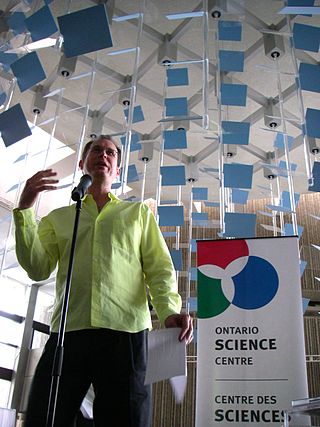
David Rokeby is a Canadian artist who has been making works of electronic, video and installation art since 1982. He lives with his wife, acclaimed pianist Eve Egoyan, in Toronto, Canada.

Mary Flanagan is an American artist, author, educator, and designer. She pioneered the field of game research with her ideas on critical play and has written several books. She is the founding director of the research laboratory and design studio Tiltfactor Lab and the CEO of the board game company Resonym. Flanagan's work as an artist has been shown around the world and won the Award of Distinction at Prix Ars Electronica in 2018.

The Lumen Prize is an international award which celebrates art created with technology, especially digital art.
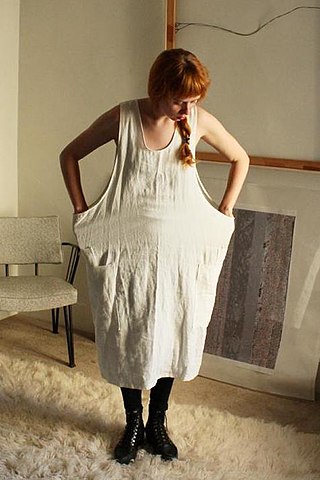
Holly Herndon is an American artist and composer based in Berlin, Germany. After studying composition at Stanford University and completing her Ph.D. at Stanford University's Center for Computer Research in Music and Acoustics, she pursued a music career internationally. Herndon's music often includes human singing voices, is primarily computer-based, and regularly uses the visual programming language Max/MSP to create custom instruments and vocal processes. She has released music on the labels RVNG Intl. and 4AD. Her third full-length album, Proto, was released on May 10, 2019.

Mario Klingemann is a German artist best known for his work involving neural networks, code, and algorithms. Klingemann was a Google Arts and Culture resident from 2016 to 2018, and he is considered as a pioneer in the use of computer learning in the arts. His works examine creativity, culture, and perception through machine learning and artificial intelligence, and have appeared at the Ars Electronica Festival, the Museum of Modern Art New York, the Metropolitan Museum of Art New York, the Photographers’ Gallery London, the Centre Pompidou Paris, and the British Library. Today he lives in Munich, where, in addition to his art under the name "Dog & Pony", he still runs a creative free space between gallery and Wunderkammer with the paper artist Alexandra Lukaschewitz.
Libby Heaney is a British artist and quantum physicist known for her pioneering work on AI and quantum computing. She works on the impact of future technologies and is widely known to be the first artist to use quantum computing as a functioning artistic medium. Her work has been featured internationally, including in the Victoria and Albert Museum, Tate Modern and the Science Gallery.
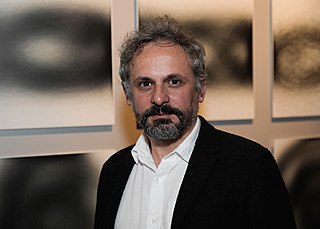
Mauro Martino is an Italian artist, designer and researcher. He is the founder and director of the Visual Artificial Intelligence Lab at IBM Research, and Professor of Practice at Northeastern University.
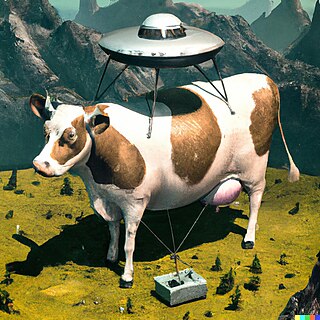
Artificial intelligence art is any visual artwork created through the use of artificial intelligence (AI) programs such as text-to-image models. AI art began to gain popularity in the mid- to late-20th century through the boom of artificial intelligence.
Natalia Fuchs is an art critic, new media researcher, international curator and cultural producer.

Ai-Da is a robotic art exhibition created by British artist Aidan Meller, which has been described by its creator as "the world's first ultra-realistic humanoid robot". Completed in 2019, Ai-Da is an android incorporating computer graphics and artificial intelligence algorithms that makes drawings, paintings, and sculptures. It is named after Ada Lovelace.
Lucas LaRochelle is a Canadian artist and designer based in Montreal, Quebec. They are best known as the creator of the community-based online collaborative mapping platform Queering the Map.
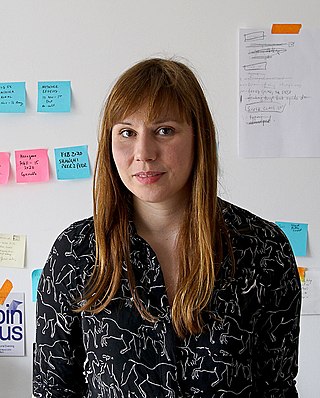
Anna Ridler is an artist and researcher who lives and works in London. She works with collections of information or data, particularly self-generated data sets, to create new and unusual narratives in a variety of mediums.

Amy Karle is an American artist, bioartist, and futurist whose work focuses on the relationship between technology and humanity, specifically how technology and biotechnology impact health, humanity, society, evolution, and the future. Karle combines science and technology with art and is known for using living tissue in her work.
Maxim Zhestkov is a London-based digital artist and designer. His significant style includes using spheres as a universal medium that represents blocks in complex structures, such as 'emotions, behaviors, thought processes, relationships, life, planets and the universe.'
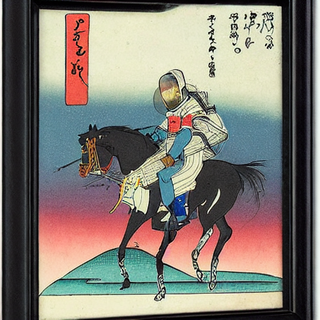
A text-to-image model is a machine learning model which takes an input natural language description and produces an image matching that description.

LAION is a German non-profit which makes open-sourced artificial intelligence models and datasets. It is best known for releasing a number of large datasets of images and captions scraped from the web which have been used to train a number of high-profile text-to-image models, including Stable Diffusion and Imagen.
Mat Dryhurst is a British artist, musician, and technological researcher based in Berlin, Germany. Dryhurst often works on interdisciplinary audiovisual projects in collaboration with Holly Herndon. The duo is known for their contributions to music and art, in which they explore the creative potential and ethics of creating content using technologies, such as AI, Web 3.0, and blockchain. Dryhurst and Herndon have been listed among Art Review's Power 100 in 2021 and 2022.
Kim Albrecht is a German media artist, information designer, and scholar known for his critical and investigative data visualizations. He is a professor at the Filmuniversität Babelsberg Konrad Wolf, principle of metaLAB (at) Harvard, and co-founder of metaLAB (at) Berlin. Albrecht earned his Ph.D. from the University of Potsdam and is a faculty associate of the Berkman Klein Center for Internet & Society.

















